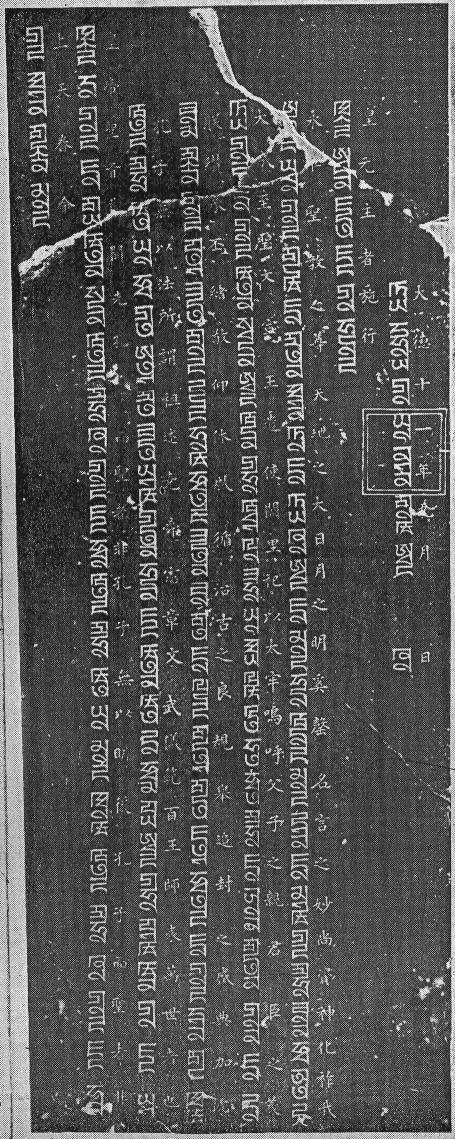
The ordinary form of the Phags-pa script, as found in Yuan dynasty inscriptions, printed texts and manuscript documents in Chinese and Mongolian, is typified by the epigraphic text below :

Source : Basibazi yu Yuandai Hanyu 八思巴字與元代漢語 Plate 10.
For some examples of standard Phags-pa script in printed and manuscript texts, see my Baijiaxing Mengguwen 百家姓蒙古文 and Menggu Ziyun 蒙古字韻 pages.
At the same time that the Phags-pa Lama devised the standard script in about 1269, he or someone else devised a pseudo-archaic "seal script" form of the letters (known as menggu zhuanzi 蒙古篆字 in Chinese). These letters mimic the labyrinthine strokes of Chinese "seal script" ideographs, and are found mainly on official seals dating from the Yuan (1271-1368) and Northern Yuan (1368-1402) dynasties, of which a large number are known. Seal script Phags-pa inscriptions may also be found in some epigraphic contexts, such as the title inscription of monumental inscriptions on stone stelae (in such cases the main text may be in Chinese, and only the title inscription in the Phags-pa script).
The Yuan dynasty rhyming dictionary Menggu Ziyun 蒙古字韻 also lists the seal script forms of various Phags-pa letters, and in general these accord with the seal script forms of Phags-pa letters found in extant seals.
Each Phags-pa letter may have several (or indeed many) variant "seal script" forms, including forms that are basically the same as the standard script as well as labyrinthine forms. Thus, for example, in most seals the word yin (for Chinese yìn 印 "seal") is written with a form of the letter YA that is similar to the standard letter YA, whereas when used to represent a final diphthong the letter YA is generally written with one of several labyrinthine forms. However, there is no hard and fast rule about using a particular form of a letter in a given position (e.g. the word yin is sometimes written with a labyrinthine form of the letter YA).
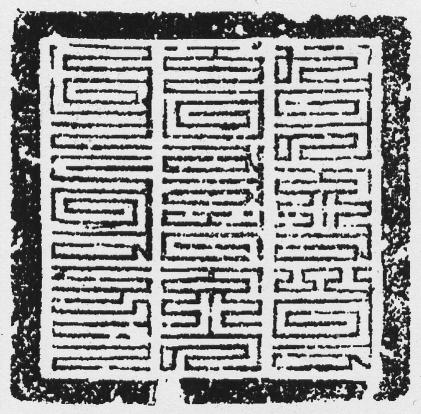
Source : Wen Wu 文物 2001.7 page 86 Illustration 2.
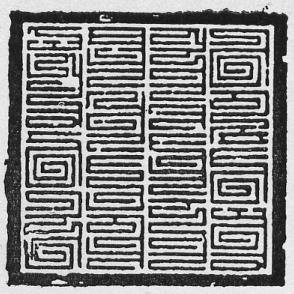
Source : Minzu Yuwen 民族語文 1997.3 Back Cover Illustration XII.
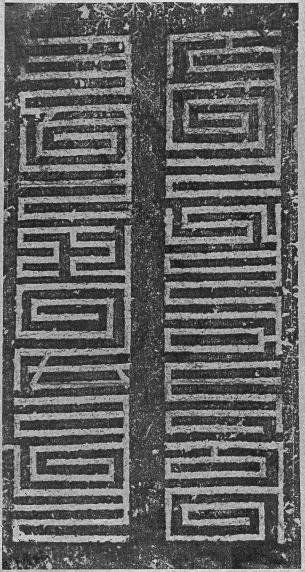
Source : Basibazi yu Yuandai Hanyu 八思巴字與元代漢語 Plate 21.
Examples of various other seals with Phags-pa inscriptions may be found in the links given on my Phags-pa Home Page.
The Phags-pa script was adapted by the Tibetans for use as a decorative script, mainly for engraving seals (for example the golden seal of the 13th Dalai Lama that was made in 1909) , inscribing book titles on the covers of traditional pecha books, and for architectural inscriptions such as those found on temple columns and doorways (for example, the pillars on either side of the alter at the St. Petersburg Buddhist Monastery [Datsan Kuntsechoinei], which was consecrated in 1915, have inscriptions in the Tibetan style Phags-pa script). This stylised variety of the Phags-pa script, which is known hor-yig gsar-pa ཧོར་ཡིག་གསར་པ་ "New Mongolian letters" in Tibetan, is squarer and more compact than the original script found in Yuan dynasty Chinese and Mongolian texts, as can be seen from the examples below.
This style of the Phags-pa script evolved from the seal script style of Phags-pa letters, and the first attested use of this style is on a golden seal that is recorded to have been given to the third Dalai Lama by Altan Khan (1507-1582) in 1578; although the original seal is now lost or destroyed, examples of imprints from seals with the same Phags-pa text are known from documents dating from 1648 and later. In 1982 a stone pillar was unearthed near Hohhot that has an inscription in Sanskrit and Mongolian, with a Phags-pa inscription on either side that records that the pillar was errected in 1580 by a grandson of Altan Khan. The style of lettering in this Phags-pa inscription is very similar to the Tibetan style Phags-pa script found in Tibetan seals and seal imprints. The close date of this stone pillar to the date of the seal of the third Dalai Lama suggests that the Tibetan style of the Phags-pa script was devised in Mongolia during the reign of Altan Khan (1543-1582).
Woodblock editions of "script primers" giving model forms of the letters of the Tibetan style Phags-pa script are not uncommon. The illustration below is a page from one such text obtained by a Buriat Cossack officer, Tsokto Garmeyevich Badmazhapov, in 1903 (the Tibetan, Mongolian, Chinese and Russian equivalents have been added by hand). Another example of such a text in the possession of Valeriy Ushakov is available at http://snark.ptc.spbu.ru/~uwe/tibex/phagspa/.
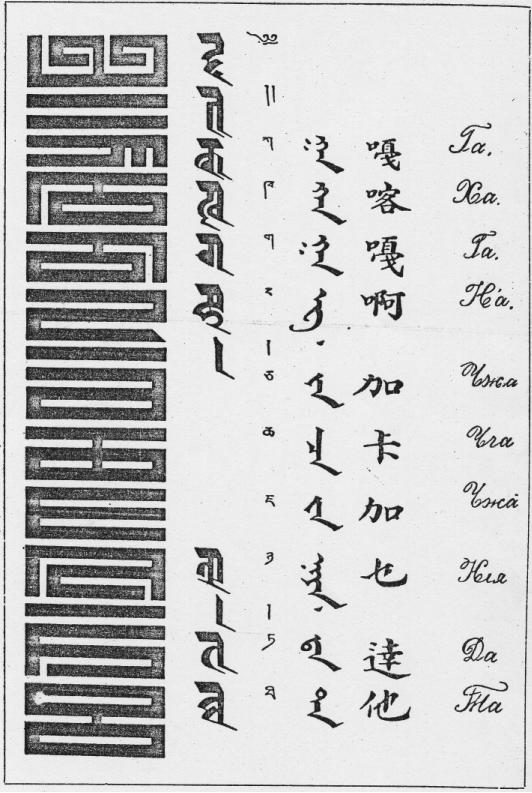
Source : The Mongolian Monuments in ḤP'AGS-PA Script page 16.
A similar set of Tibetan Phags-pa letters are also given by Pozdneyev (see Pozdneyev 1897 page 192), as well as an inscription reading bkra shis -bar -gyur gcig for Tibetan བཀྲ་ཤིས་འབར་འགྱུར་གཅིག༎ "May You Enjoy Prosperity !". Note that in this example many of the letters are joined down the central axis rather than down the right-hand side as is normal.
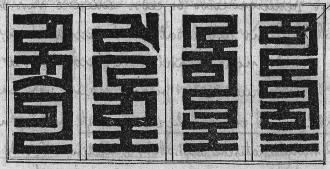
Source : Лекціи по исторіи монгольской литературы page 192.
The following table lists the forms of Phags-pa letters used in the standard script style, Tibetan script style and Seal script style.
N.B. To view the characters in the table you must install the free Phags-pa fonts from my fonts page.
| Uniode Code Point | Character Name | Standard Style | Tibetan Style | Seal Script Style |
|---|---|---|---|---|
| U+A840 | KA | ꡀ | ꡀ |   |
| U+A841 | KHA | ꡁ | ꡁ |   |
| U+A842 | GA | ꡂ | ꡂ |     |
| U+A843 | NGA | ꡃ | ꡃ |    |
| U+A844 | CA | ꡄ | ꡄ |   |
| U+A845 | CHA | ꡅ | ꡅ |    |
| U+A846 | JA | ꡆ | ꡆ |    |
| U+A847 | NYA | ꡇ | ꡇ |   |
| U+A848 | TA | ꡈ | ꡈ |    |
| U+A849 | THA | ꡉ | ꡉ |   |
| U+A84A | DA | ꡊ | ꡊ |  |
| U+A84B | NA | ꡋ | ꡋ |         |
| U+A869 | TTA | ꡩ | ||
| U+A86A | TTHA | ꡪ | ||
| U+A86B | DDA | ꡫ | ||
| U+A86C | NNA | ꡬ | ||
| U+A84C | PA | ꡌ | ꡌ |   |
| U+A84D | PHA | ꡍ | ꡍ |   |
| U+A84E | BA | ꡎ | ꡎ |    |
| U+A84F | MA | ꡏ | ꡏ |    |
| U+A850 | TSA | ꡐ | ꡐ | |
| U+A851 | TSHA | ꡑ | ꡑ |   |
| U+A852 | DZA | ꡒ | ꡒ |   |
| U+A853 | WA | ꡓ | ꡓ |     |
| U+A854 | ZHA | ꡔ | ꡔ |  |
| U+A855 | ZA | ꡕ | ꡕ |   |
| U+A856 | -A | ꡖ | ꡖ |   |
| U+A857 | YA | ꡗ | ꡗ |        |
| U+A858 | RA | ꡘ | ꡘ |  |
| U+A859 | LA | ꡙ | ꡙ |    |
| U+A85A | SHA | ꡚ | ꡚ |    |
| U+A85B | SA | ꡛ | ꡛ |    |
| U+A85C | HA | ꡜ | ꡜ |   |
| U+A85D | A | ꡝ | ꡝ |     |
| U+A862 | QA | ꡢ | ||
| U+A863 | XA | ꡣ |   |
|
| U+A864 | FA | ꡤ |     |
|
| U+A865 | GGA | ꡥ |  |
|
| U+A867 | Subjoined WA | ꡧ | ꡧ |  |
| U+A868 | Subjoined YA | ꡨ | ꡨ |  |
| U+A871 | Subjoined RA | ꡱ | ꡱ | |
| U+A872 | Superfixed RA | ꡲ | ꡲ | |
| U+A85E | I | ꡞ | ꡞ |        |
| U+A85F | U | ꡟ | ꡟ |      |
| U+A860 | E | ꡠ | ꡠ |   |
| U+A861 | O | ꡡ | ꡡ |   |
| U+A866 | EE | ꡦ |  |
|
| U+A873 | Candrabindu | ꡳ | ||
| U+A874 | Single Head Mark | ꡴ | ||
| U+A875 | Double Head Mark | ꡵ | ||
| U+A876 | Shad | ꡶ | ||
| U+A877 | Double Shad | ꡷ |
Date: 2006-12-21
Forty-One Letters | Old Uighur Script | Baijiaxing Mengguwen | Menggu Ziyun